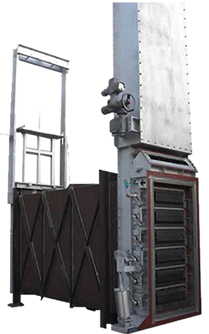Products


Low leakage slide gate isolation dampers are primarily used for isolation purposes where low levels of leakage and pressure drop are required. Low leakage slide gate isolation dampers are available with chain drive and electric motor actuators.
Self cleaning stainless steel blade seals are incorporated around the full inside perimeter of the damper frame. The atmospheric blade seal is furnished along the face and edges of the damper blade to minimize leakage into or from the atmosphere.
Are available for systems which experience build up around the blade seals. The dual blade concept enables each blade to be fully stroked separately, allowing the blade seals to be cleaned without taking the flue gas system out of service.
Are used when isolation is required for a system, by employing dual blades that provide an air chamber achieving zero leakage. Machine screws with protective boots and electric motors are supplied for open-close service. An isolation valve is furnished to prevent flue gas leakage to the atmosphere when the seal air fan is not operating.
ProcessBarron's skilled team of craftsmen manufacture and assemble specialty dampers in-house at our own facilities. Our field service department specializes in turn-key installation of new dampers and the inspection, maintenance, and thorough analysis of problems with existing equipment.
All ProcessBarron slide gate dampers are test-operated prior to shipment or on-site installation. Custom slide gate dampers and guillotine dampers are designed, manufactured, shop assembled, and tested in-house at our facilities in INDIA
The guillotine damper, or slide gate damper as it is sometimes called, has the main function of isolation of equipment to permit inspection, maintenance, or repair in addition to process isolation. Occasionally, guillotine dampers are specified for bypass ducts, if operation requirements allow enough time for the slow-moving blade to travel across the opening.
The basic mechanical elements of the guillotine damper are a blade, a peripheral-seal system to prevent gas leakage at all stages of blade movement, support members for the blade , and a drive to move the blade steadily and continuously from open to closed and back again.
The guillotine damper has these advantages :
But this damper also has drawbacks :
In addition, the guillotine damper generally requires more care in design and construction of the seals. Perhaps this is because gas-tightness requirements are higher for guillotines than for louvers, but the fact remains that, in many guillotine dampers, the blade drags past most of the seal perimeter for the full stroke, making heavier demands on the seal material.
Where flow control is not required but positive shut off is mandatory, guillotine dampers are the most logical choice. The amount of allowable leakage determines the seal design. Rigid seats provide adequate closure, with leakage in the range of 0.4 to 1% of flow. When zero leakage of flue gas is required, a seal air system must be added. Flexible seals reduce air requirements.
The simplest form of guillotine damper is the single-thickness flat plate blade. The one-piece blade provides verifiable closure of the duct with minimal leakage at the blade edges. Seals are provided to control leakage where the blade enters the duct section. These seals can be air sealed to contain gases in a positive pressure duct. Leak paths are typically less than 0.1% of duct area with resulting flow leakage of 0.4 to 1.1%. The blade guides insure smooth operation and are self cleaning in deposit producing environments.
As a general rule, flat-plate open-bonnet guillotine dampers are not suggested for systems with elevated temperatures (above 500 deg. F).
Our expertise lies in designing and developingGuillotine Dampers with optimum quality. These offered products ensure 100% sealing efficiency with/without seal air fan. We manufacture huge quantities of the single-thickness flat plate blade that its also known as Guillotine Dampers. These dampers are featured with peripheral-seal system for stopping gas leakage at all stages of blade movement and to give support to the members for the blade. Along with this, these products are provided with a drive to move the blade steadily and continuously from open to closed and back again. Compact design of these dampers demands less space and less maintenance. We also make them resistant to various damages that can occur from furnace puffs and mild over pressure incidents.
Features: